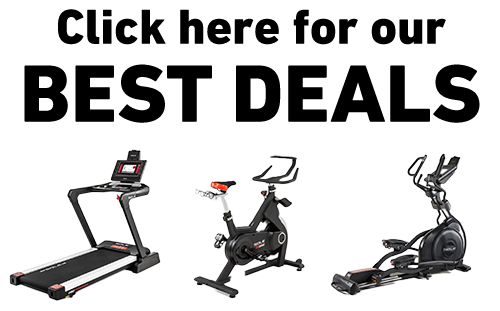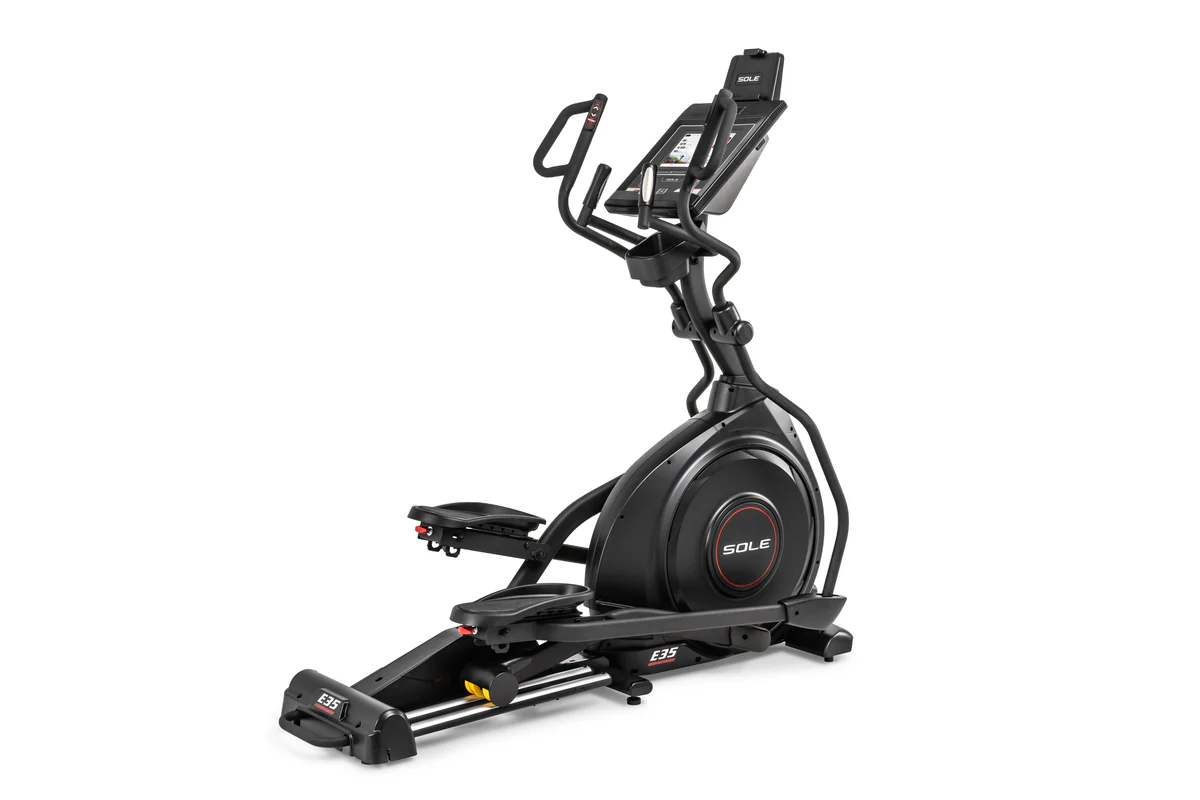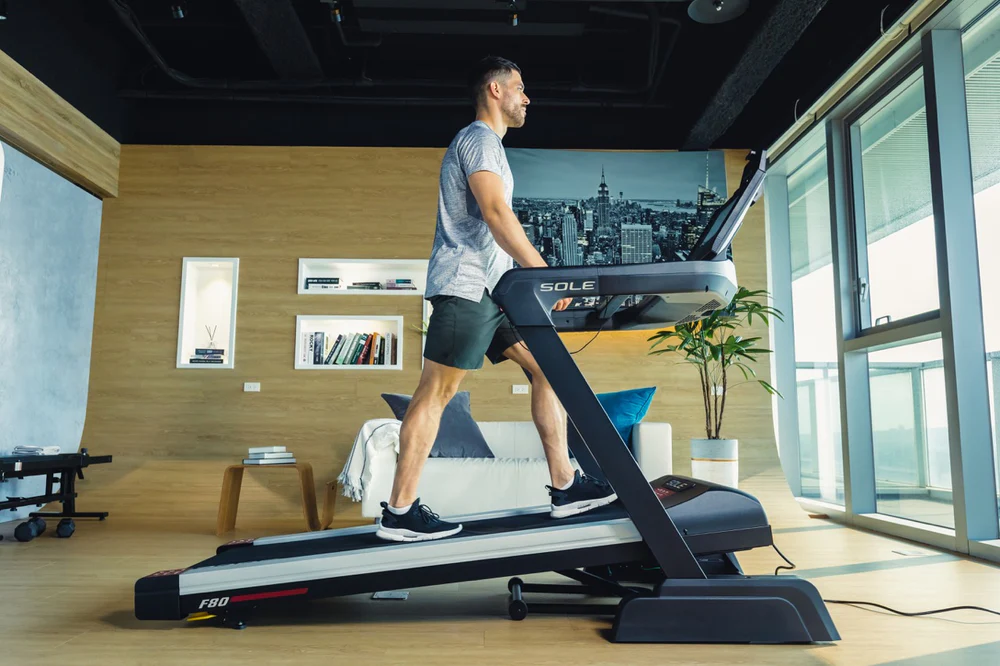Key Takeaways
- Elliptical wobbling can be caused by improper leveling, loose frame bolts, unstable flooring, or design flaws.
- To diagnose the wobble, check the leveling feet, inspect the bolts, evaluate the floor surface, and assess the elliptical design.
- Fixing the wobble involves balancing the feet, tightening frame bolts, and stabilizing the base.
- Preventive maintenance tips include regular inspections, lubricating moving parts, and proper setup and positioning.
- SOLE elliptical models offer robust construction and design to minimize wobbling issues.
|
At SOLE Fitness, we’re proud to offer the best treadmills for your home or gym. These machines are crafted to meet the highest standards of quality and performance, ensuring they are ideal for anyone - from fitness novices to seasoned athletes. Featured Products SOLE Ellipticals: Priced from $1,199.99, SOLE ellipticals are known for their ergonomic design, durability, and affordability. They provide a quiet, smooth workout with intuitive consoles, adjustable stride lengths, incline options, and heart rate monitoring, ensuring a comprehensive exercise experience. |
Common Causes of Elliptical Wobbling
If you've ever felt your elliptical wobbling during a workout, you know how frustrating it can be. A wobbling elliptical disrupts your exercise routine and can also be a safety hazard. Here are the common causes of elliptical wobbling and how to fix it effectively.
Improper Leveling
One of the most common causes of elliptical wobbling is improper leveling. Most ellipticals come with adjustable leveling feet, and if these feet are not correctly adjusted, the machine may rock or wobble during use. This issue is especially common if the elliptical is placed on an uneven surface.
Loose Frame Bolts
Over time, the bolts that hold the elliptical frame together can become loose, leading to instability. This is particularly common if the elliptical has been moved or if it has been in use for an extended period. Regularly checking and tightening these bolts can prevent wobbling.
Unstable Flooring
The surface on which the elliptical is placed can also contribute to wobbling: an uneven or soft floor (like carpet) can cause the machine to rock. Ensuring that the area where the elliptical is placed is level is crucial for stability.
- Place the elliptical on a solid, level surface.
- Avoid placing the machine on thick carpets or rugs.
- Consider using an equipment mat to provide a stable base.
At SOLE, we also sell a high-quality equipment mat. It’s a standard black 1/4" PVC vinyl and nitrile rubber with a dimension of 36.5" x 78", durable enough to protect any surface - hardwood, stone, or carpet. The mat can prevent fibers from rugs and debris from entering your elliptical and reduce vibration - this can make your equipment last for a long time.

Design Flaws
Sometimes, the design of the elliptical itself can cause wobbling - this could be due to a weak frame structure or poor construction. If you suspect that the design is the issue, it may be worth considering a more robust model like those offered by SOLE - or example, our E98 was specifically designed for use in commercial establishments and is highly popular in light commercial settings. It’s also one of our heavier models at 246 lbs - our E95s is our heaviest model at 265lbs. They both should withstand wobbling.
Diagnosing the Wobble
Before you can fix the wobble, you need to diagnose what’s causing it. Here’s how you can do that:
Checking Leveling Feet
Start by checking the leveling feet. Most ellipticals have adjustable feet that can be raised or lowered to ensure the machine is level - if the feet are not properly adjusted, the elliptical will rock during use.
Inspecting Bolts
Next, inspect all the bolts on the elliptical frame. Look for any that are loose and tighten them as needed - it’s a simple step can often resolve wobbling issues.
Evaluating Floor Surface
Start by checking for any dips or uneven areas where the elliptical is placed - if the surface is not level, the elliptical will rock during use. If you find that the floor is uneven, consider moving the elliptical to a different location with a more stable surface.
Hardwood floors or concrete surfaces are ideal for minimizing wobbling. If moving the elliptical is not an option, you can use a piece of plywood underneath the machine to create a more stable base.
Assessing Elliptical DesignEllipticals with a weak frame structure or poor construction are more prone to instability, so if you suspect that the design is the issue, it might be time to consider investing in a more robust model.
Our ellipticals, for example, stand out for their solid construction and durability - more affordable models like the E25 and E35 are designed with high-quality materials and engineering to provide a stable and smooth workout experience. Investing in a well-designed elliptical can save you from the hassle of dealing with wobbling issues.

Fixing the Wobble
Balancing the Feet
Start by adjusting the leveling feet; most ellipticals come with adjustable feet that can be raised or lowered to ensure the machine is level. To balance the feet, follow these steps:
- Place a level on the base of the elliptical.
- Adjust the leveling feet by turning them clockwise or counterclockwise until the machine is level.
- Check the level from different angles to ensure the machine is balanced.
Properly balanced feet can significantly reduce wobbling and improve the stability of your elliptical. Different brands have different level adjusting methods - consult the manual that came with your equipment.
Adjusting Feet
Sometimes, simply balancing the feet is not enough. You may need to make more precise adjustments to ensure stability. Here’s how to do it:
First, check each foot individually - if one foot is higher or lower than the others, adjust it until all feet are even. You can use a wrench or pliers to make the adjustments. Make sure to check the level of the machine after each adjustment to ensure it remains balanced.
Securing Jam Nuts
After adjusting the feet, it's essential to secure the jam nuts, which lock the leveling feet in place and prevent them from moving during use. To secure the jam nuts, follow these steps:
- Use a wrench to tighten the jam nuts against the base of the elliptical.
- Ensure the nuts are tight enough to prevent any movement but not so tight that they damage the feet.
- Double-check the level of the machine after securing the jam nuts.
Securing the jam nuts will help maintain the stability of your elliptical and prevent future wobbling issues.
Tightening Frame Bolts
Loose frame bolts are also a common cause of elliptical wobbling - to tighten them, you’ll need a set of tools and a bit of patience. Here’s what you need to do:
Tools Needed
You'll typically need a wrench or an Allen key, depending on the type of bolts used in your elliptical.
- Wrench or Allen key
- Socket set (optional)
- Thread locker (optional)
Steps to Tighten
Now that you have your tools, follow these steps to tighten the frame bolts:
- Identify all the frame bolts on your elliptical.
- Use the wrench or Allen key to tighten each bolt. Turn the bolts clockwise to tighten them.
- If any bolts are particularly loose, consider using a thread locker to secure them in place.
- After tightening all the bolts, check the stability of the elliptical by using it for a few minutes.
Regularly tightening the frame bolts can prevent wobbling and ensure a smooth workout experience.
Stabilizing the Base
In addition to balancing the feet and tightening the frame bolts, you can take extra steps to stabilize the base of your elliptical. Here are a few options:
- Use an equipment mat to provide a stable and non-slip surface.
- Place a piece of plywood under the elliptical to create a more solid base.
- Ensure the elliptical is positioned on a level and hard surface.
Adding Plywood
If the floor surface is uneven or soft, adding a piece of plywood under the elliptical can help create a more stable base. Here’s how to do it:
- Measure the dimensions of your elliptical base.
- Cut a piece of plywood to match these dimensions.
- Place the plywood on the floor where you plan to use the elliptical.
- Position the elliptical on top of the plywood, ensuring it is centered and stable.
Using plywood can help distribute the weight of the elliptical more evenly and prevent it from rocking during use.

Preventive Maintenance Tips
Regular Inspections
Perform regular inspections of your elliptical to identify any potential issues before they become major problems. Check the leveling feet, frame bolts, and overall stability of the machine. Address any issues promptly to maintain a smooth and stable workout experience.
Lubricating Moving Parts
Lubricating the moving parts of your elliptical can help reduce friction and prevent wear and tear. Use a high-quality lubricant specifically designed for fitness equipment and apply it to the joints, pedals, and other moving parts as recommended by the manufacturer.
Proper Setup and Positioning
Ensure that your elliptical is set up and positioned correctly. Place the machine on a level and hard surface, and use an equipment mat if necessary. Avoid placing the elliptical on thick carpets or rugs, as these can contribute to instability.
Stop Your Elliptical from Wobbling
Elliptical wobbling can be a frustrating issue that disrupts your workout and poses safety risks. Common causes include improper leveling, loose frame bolts, unstable flooring, and design flaws. To diagnose and fix the wobble, check and balance the leveling feet, tighten frame bolts, and ensure a stable base. Preventive maintenance, such as regular inspections, lubricating moving parts, and proper setup, is key to avoiding these problems.
SOLE ellipticals have robust construction and high-quality materials to minimize wobbling and ensure a smooth, stable workout experience. With regular maintenance and proper setup, you can enjoy the full benefits of your elliptical for years to come.
Frequently Asked Questions (FAQ)
How often should I check the bolts?
It's a good idea to check the bolts on your elliptical at least once a month. Regularly tightening the bolts can prevent them from becoming loose and causing wobbling issues; if you use your elliptical frequently, consider checking the bolts more often.
Can a wobbling elliptical cause injuries?
Yes, a wobbling elliptical can cause injuries - an unstable machine can lead to falls or strains, especially during intense workouts. Ensuring that your elliptical is stable and secure is essential for a safe and effective exercise routine.
Does carpet affect the stability?
Yes, placing an elliptical on a thick carpet can affect its stability. Carpets can create an uneven surface and cause the machine to rock during use. To improve stability, consider placing the elliptical on a hard surface or using an equipment mat to provide a stable base.
Why should I consider investing in a SOLE elliptical?
SOLE ellipticals are special for their robust construction and high-quality materials, which help minimize wobbling and ensure a stable workout. Investing in a SOLE elliptical ensures reliable, durable equipment that, with regular maintenance, will offer a smooth and effective workout experience for years. If you have any issues with your SOLE elliptical, you’re covered with the long warranty too.




Leave a comment
This site is protected by hCaptcha and the hCaptcha Privacy Policy and Terms of Service apply.